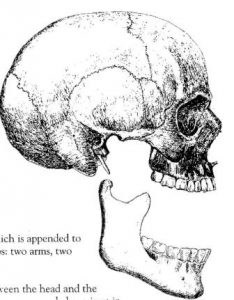Five Limbs
Lately during sitting meditation, I often feel my jaw clenching. I notice it as I "come back" to the present moment when my mind has wandered. Frequently my wandering thoughts are future-oriented: planning strategies, reviewing a run-down of tasks to be accomplished, ruminating on what will happen, imagining conversations with people, that sort of thing. I'm beginning to think that the future itself makes me tense (which is odd, since it doesn't actually exist and never will). It is certainly a relief to stay in the present moment, easier to feel relaxed right here, right now. This doesn't just happen in meditation, I clench in many situations: driving in rush hour traffic, reading a contentious thread on social media, picking up the phone to make a difficult call, hearing Donald Trump speak. It can happen when I'm watching an exciting show on TV, or pulling weeds, or even when I'm enjoying something pleasurable.
So I release my jaw a lot, sometimes multiple times a day, and it is always interesting to notice what has triggered this stress response. As with meditation, it's almost always when my mind is spinning out stories about the future. These stories are fueled by anxiety, regardless of whether the content is positive or negative. I don't know about you, but when I think ahead into the future, it's never with a sense of ease and faith in the outcome; worry infuses my thinking. This has become so commonplace that I barely notice it -- except when I feel that tension in my jaw.
This is what one Alexander student calls "the canary in the coal mine," an obvious physical symptom that gets your attention and calls you into awareness of a larger situation. In Insight meditation we might call it a "mindfulness bell," waking you up to what's real, right now.
Whenever I notice this jaw clenching, I let it go. It's a simple solution that works every time. There's nothing subtle or complex about it. I feel that pressure in between my teeth, a tightness just below my ears, and all I have to do is let it drop, peel my tongue off the roof of my mouth and let it rest on the bottom.
Yet I hear people saying that they have trouble letting it go, that they have tried to relax and stop the clenching, but they can't seem to do it. Releasing the jaw is easy to do, when you know what it is you want to release. Here are some facts that are important to understand if you want to ease your jaw tension:
- The jaw is not part of your head. It's attached to it, yes, but is quite separate from the skull. AT teacher Barbara Conable rightly points out that the mandible (jaw bone) is an extra added feature of the main frame of our skeleton. We have five limbs: two legs, two arms, and one jaw.
- One jaw. Not two, as many people think. There is no "upper" jaw, that's the bottom of the skull. Touch the roof of your mouth with the tip of your tongue; you are contacting the bottom of the skull. There's a guided meditation that I can no longer listen to because the teacher keeps asking me to "relax your lower jaw and soften your upper jaw." Huh? I'm not sure that's anatomically possible.
- Releasing jaw tension is an opportunity to cultivate patience. It's a little like housework -- you do it once but pretty soon you're just going to have to do it again. The masseter muscles are said to be some of the most powerful (uterus muscles are the strongest), and they are part of an old and well-established reflex that makes us bite down when under attack or afraid. It requires patience to accept that the jaw is going to keep tensing up and it may take many mindful moments of release to change this pattern.
Welcome back to the present moment. Please remember to include all five limbs as you move through your day.
